Fantastic (free) synths and how to use them: Dexed
We take on Digital Surburban's stellar recreation of the iconic Yamaha DX7

PLUGIN WEEK 2023: In the late 1960s, whilst studying digital implementations within music and acoustics, Professor John Chowning of Stanford University made what would become a revolutionary discovery.
He found that modulating a sine wave oscillator with another sine-wave oscillator of relative pitch (digitally controlled for precision), one could create harmonically rich, complex and musical waveforms, the likes of which were not possible with any other forms of technology at the time. By 1975, he had refined his discovery into a working digital process that he called Frequency Modulation.
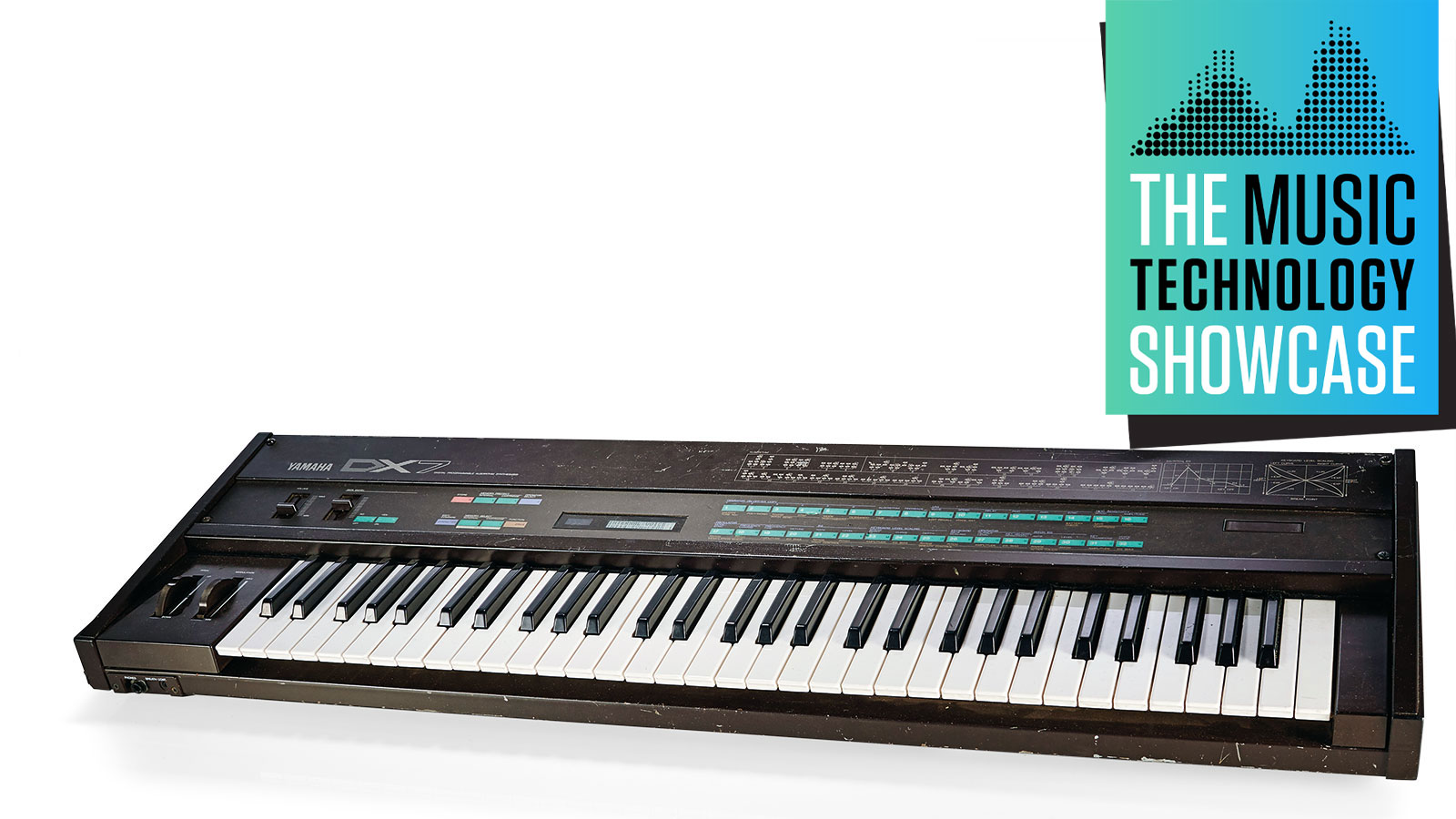
Chowning would go on to partner with Yamaha and assist in developing a synthesiser based on his Frequency Modulation technique. The synthesiser in question was the Yamaha DX7, and its release in 1983 was a watershed moment for the music industry. The new tones and sounds that the DX7 could create, the likes of which had never been heard before, took the music industry by storm as artists from a wide range of genres began using DX7s in their production process.
The DX7 quickly became the backbone of popular music, being used on countless records and smash hits. I would even argue that it's possible to categorise 1980s music into two eras; the pre-DX7 era and the post-DX7 era, such was the widespread use of this new instrument and its distinct timbral character.
Furthermore, it heralded a new era of microchip-based, digital synths (as opposed to analogue), that would rely heavily on “preset” user-interfacing. The digital-preset-synth format quickly became the industry-standard and what we’ve become accustomed to today.

Digital Suburban's Dexed is a free software synthesiser based on the iconic Yamaha DX7. For all intents and purposes, there’s very little difference between their operating processes and architecture; so much so that Dexed is capable of loading original Yamaha DX7 preset files (something we’ll explore in more detail later in this article).
It’s important to note that because the DX7 is a digital synth, it’s possible to recreate its sound very accurately, without the need for complex, processor-heavy analogue modelling algorithms (something many other software synthesisers require, in order to emulate old, iconic synths).
Want all the hottest music and gear news, reviews, deals, features and more, direct to your inbox? Sign up here.
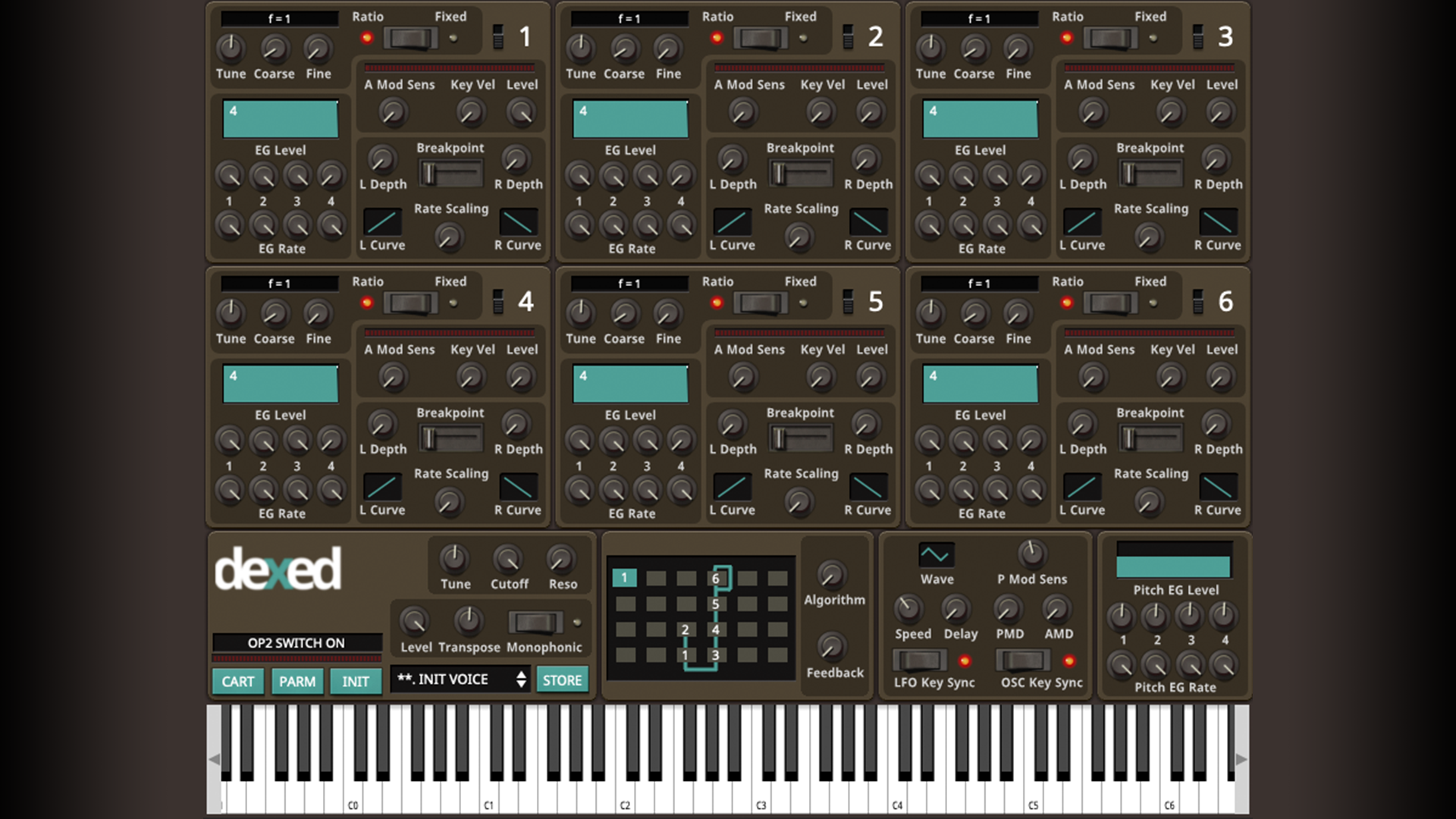
FM synthesis vs. subtractive synthesis
As discussed in our previous free synth tutorials, subtractive synthesisers use oscillators to create a tone full of harmonic information. This richly detailed harmonic information is then filtered (or subtracted) from the signal to varying degrees, shaping the tone to the player’s preference.
Linear Frequency Modulation (or FM synthesis for short) on the other hand starts with a sine-wave (containing only a fundamental pitch and no additional harmonic information), and adds harmonic content by modulating the sine-wave with another sine-wave.
The greater the modulation, the more complex and detailed the harmonic information present in the generated tone, and thus FM synthesis is capable of creating tones and wave-shapes of near limitless complexity (something that subtractive synthesisers are not capable of).
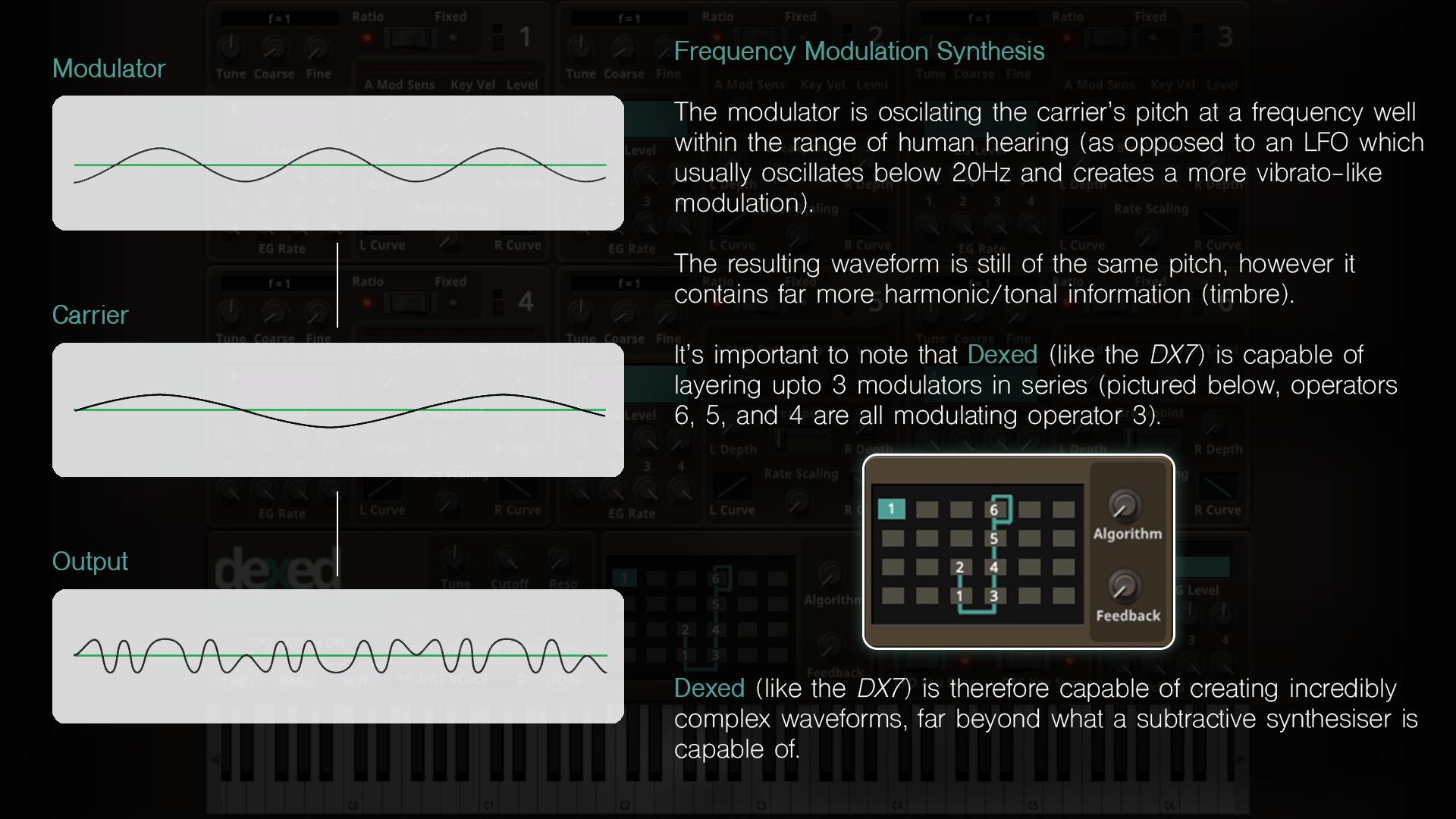
It's worth nothing that some early analogue synths made use of exponential FM synthesis, but this is very different to the digital, linear FM synthesis found in Yamaha’s DX synthesisers, and not really comparable in terms of controllable tone design.
Operators and algorithms
Dexed (like the DX7) uses an architectural principle of Operators. An operator consists of a sine-wave oscillator (with associated tuning controls), an envelope, and other keyboard/velocity parameters. The envelopes are slightly different to the ADSR envelopes that you may be accustomed to, but have a little experiment and you’ll quickly get the hang of them.
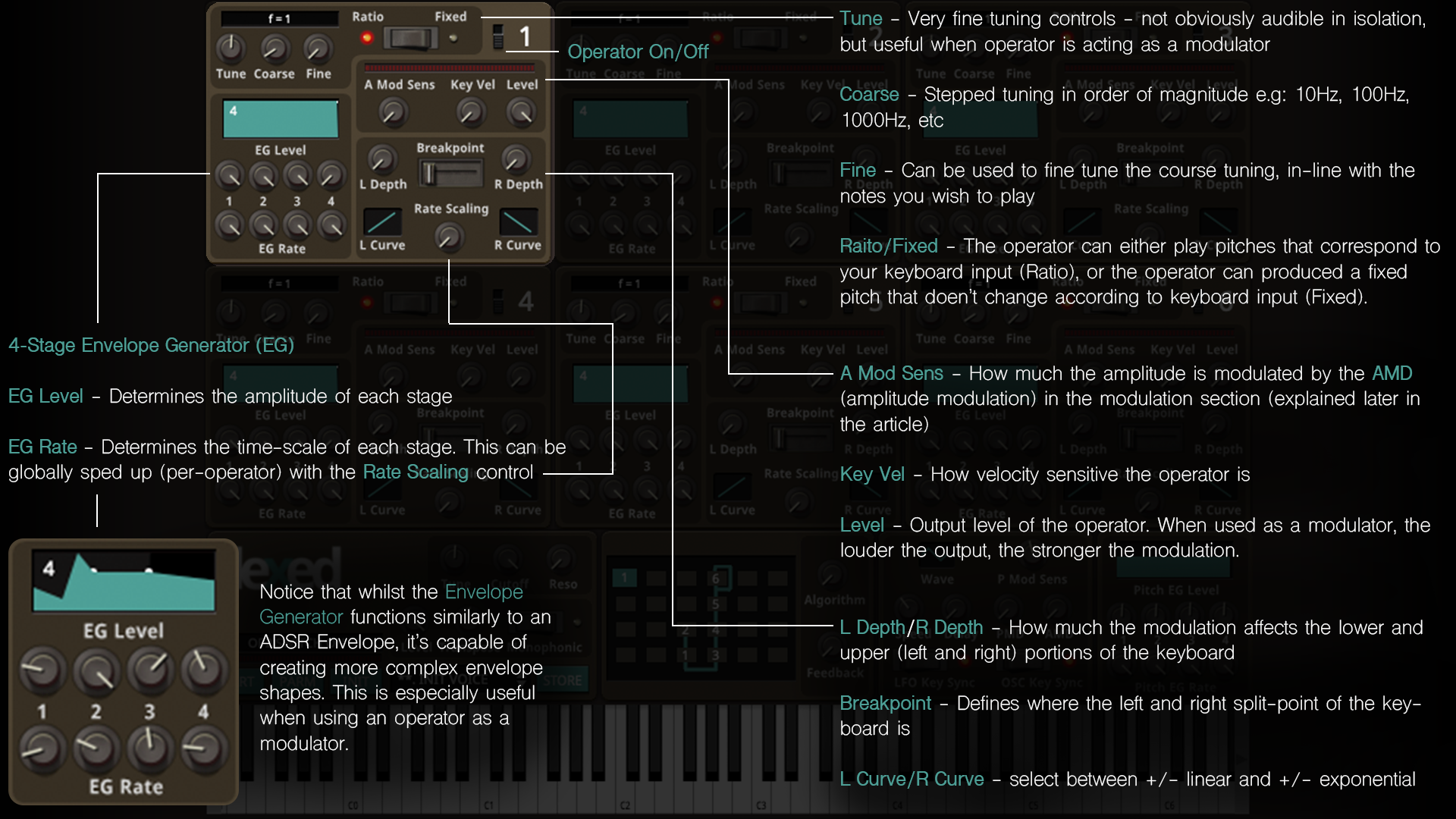
Like the DX7, there are six operators in Dexed, but they’re all identical and work the same way, so once you’ve familiarised yourself with one, you’ll understand all six (despite it seeming very complicated, the DX7 (and Dexed) is actually quite a straight-forward synthesiser in this regard).
Keep in mind that an operator can be configured to be either an audible source of sound (known as a “Carrier”), or a tone-controlling, non-audible oscillator (known as a “Modulator”).
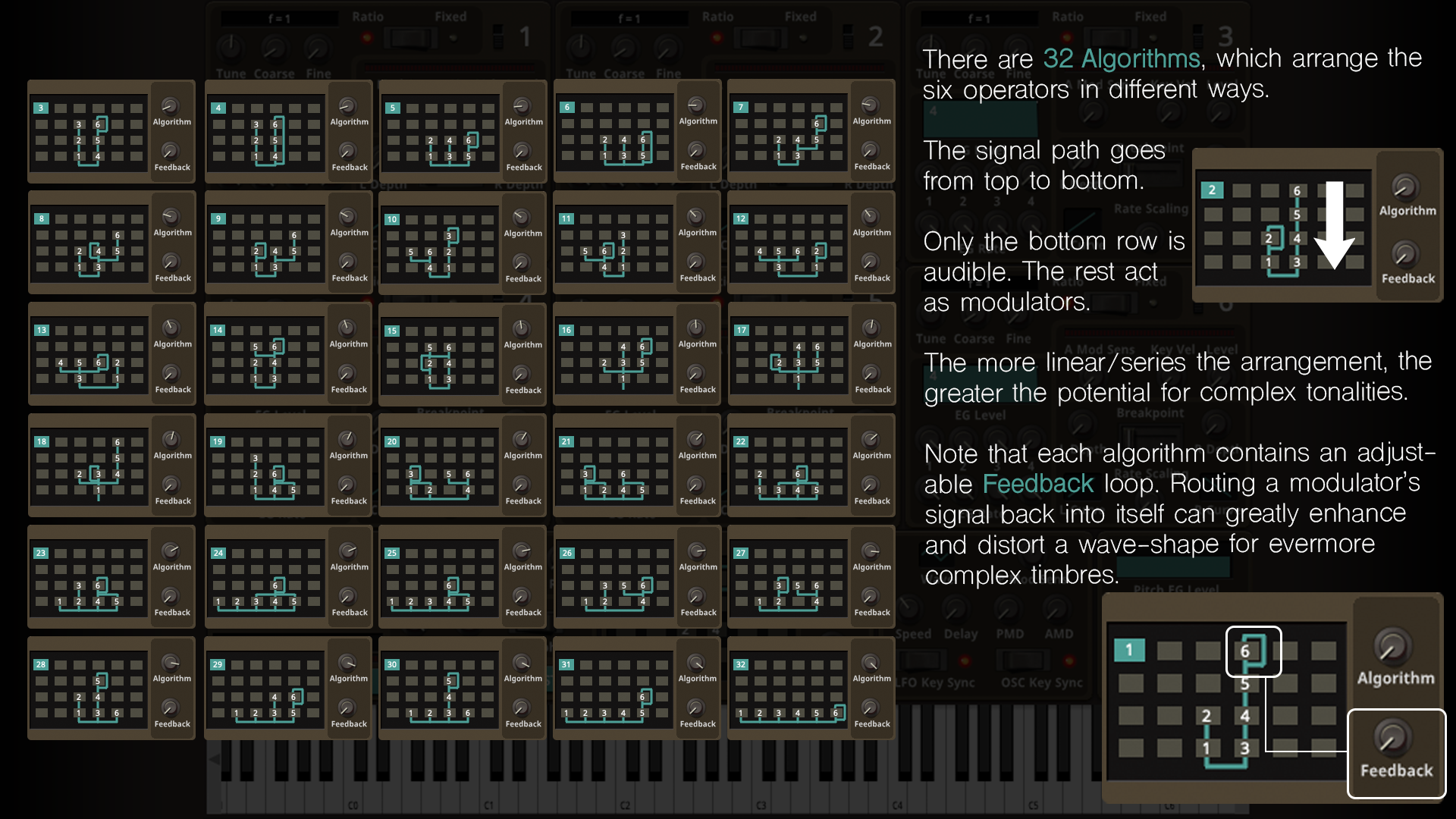
There are 32 algorithms; 32 different operator configurations, each with their own distinctive tonal colour. The diagram on the Algorithm section of the synthesiser represents signal flow in a top-down fashion, i.e. the operators at the bottom of the diagram are the ones that actually make sound, and any above them, are modulating controllers. There is also a feedback loop which can induce evermore texture and to a tone.
Global controls

The LFO is simple, but effective; assignable to both amplitude and pitch. The pitch modulation is global, whereas the amplitude modulation can be adjusted on an operator-by-operator basis, meaning you can create some very interesting modulating timbres.
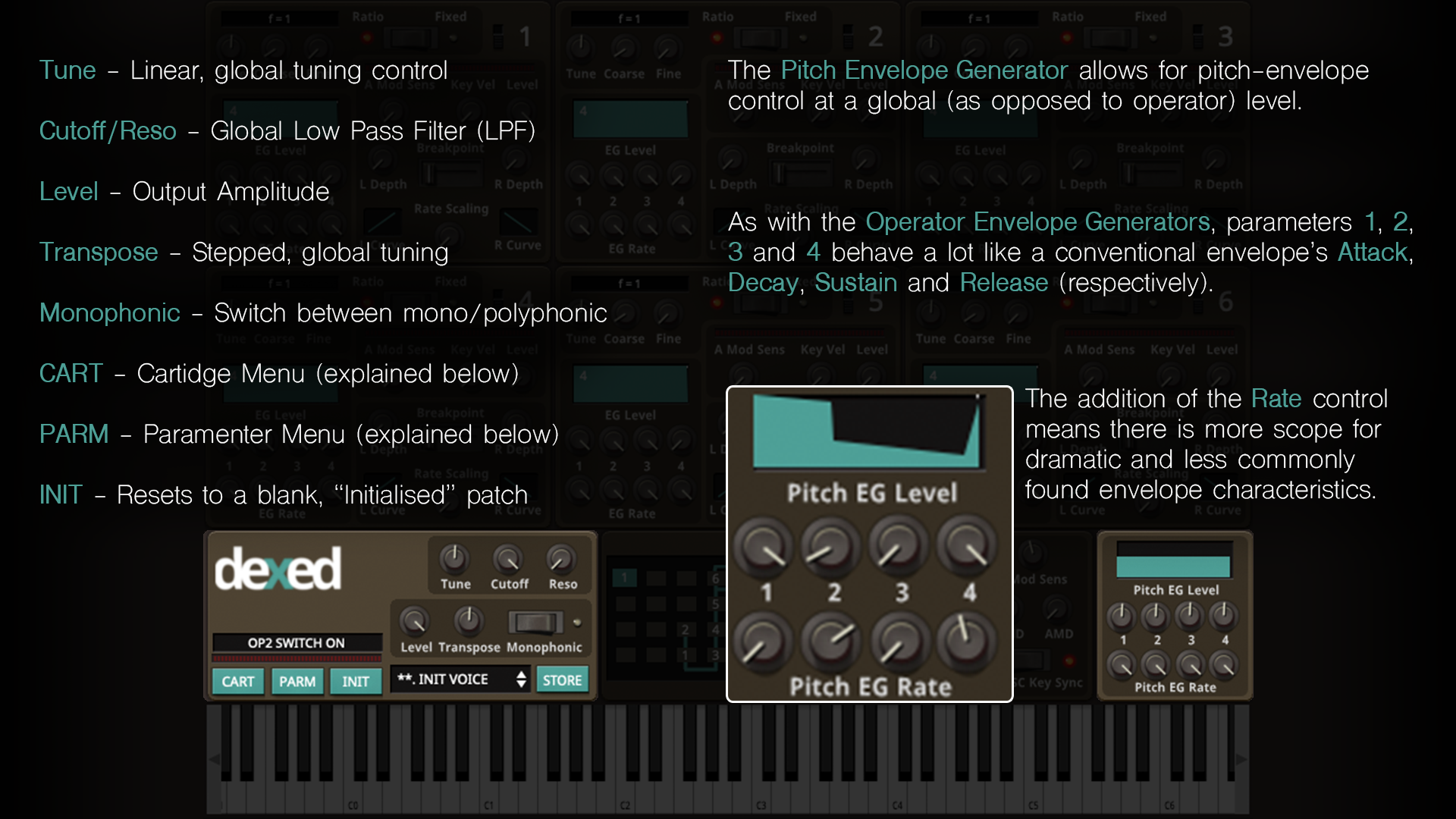
PARM - parameter menu
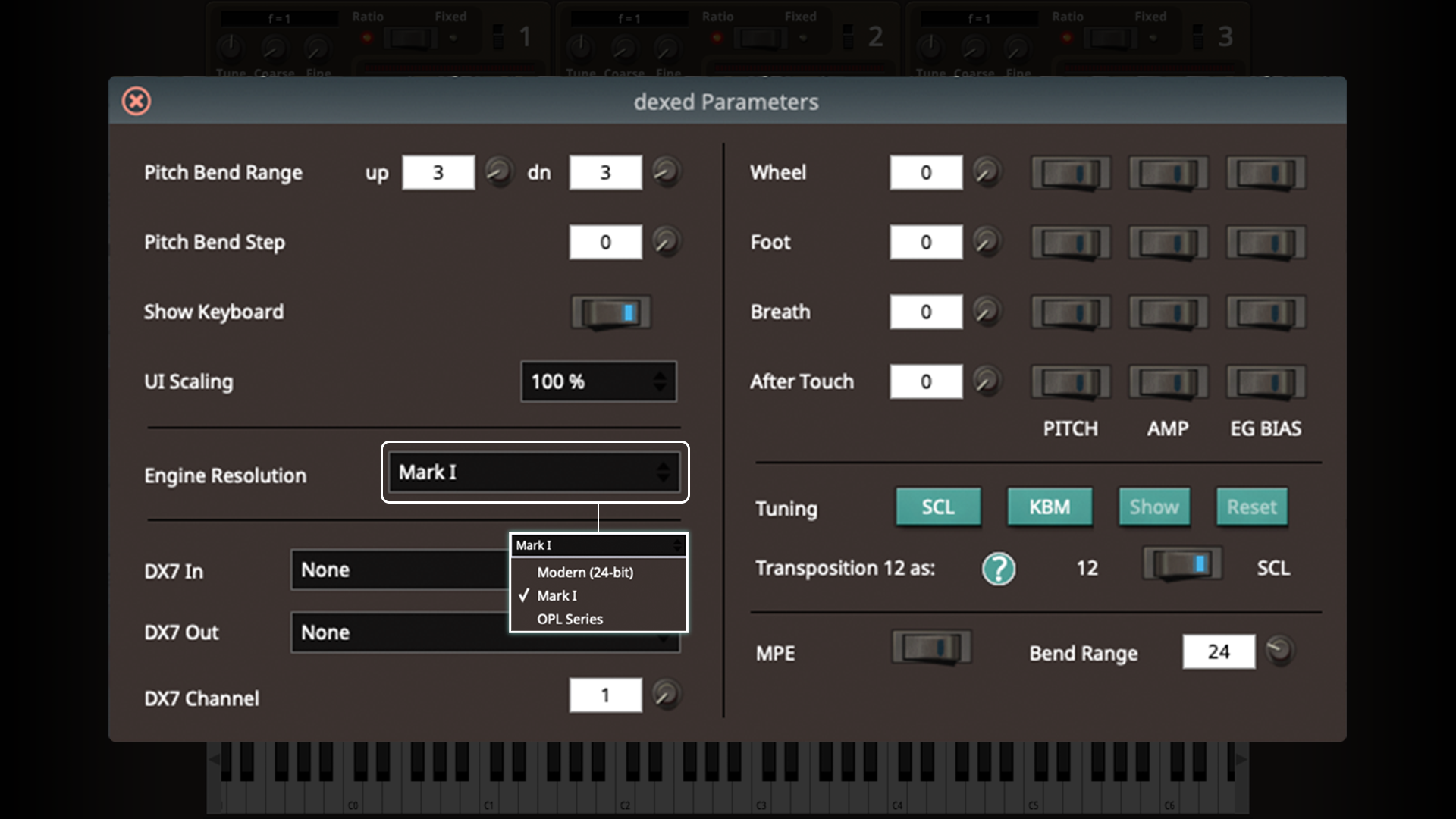
Here we can set a number of global parameters related to the functionality of the synth. Whilst some are straight forward, some are quite unique.
Pitch Bend Range up/dn - Fairly self explanatory; how many semitones does the pitch-bend bend!
Pitch Bend Step - Instead of bending, you can set the pitch bend to step a predetermined number of intervals - I like this feature a lot, as it can be used very expressively when soloing
Show Keyboards - Shows/hides the keyboard on the user interface
UI Scaling - Changes to size of the user interface (although the image resolution remains the same, so it can get a bit pixelated at 150%)
Engine Resolution - For subtly different characteristics in the overall tone creation, try switching between Modern (24 Bit), Mark I (akin to the original chip-set used on the DX7), and OPL Series (a revised chipset used by Yamaha for FM synthesis in the late 1980s). By default Dexed is set to Mark I. There’s no right or wrong option here, they’re just different flavours of modulation characteristics.
DX7 In/Out/Channel - This allows you to specify which MIDI input/output device and MIDI channel you wish to assign the synth to (note that when these are assigned to “None”, your DAW’s global settings will take priority).
Wheel/Foot/Breath/After Touch Matrix - Here you can specify how you want mod-wheel, foot-control, breath-control and after-touch MIDI commands to behave. They can be assigned to PITCH, AMP (amplitude) and EG BIAS (envelope generator strength/sensitivity).
Tuning SCL/KBM - Allows you load in a custom tuning scale and keyboard mapping file
Transposition 12 as:... and SCL (scale) - This feature (along with the above-mentioned custom tuning scale and keyboard mapping) refers to the re-tuning of irregular intervaled instruments. Adjusting these settings is only likely to be necessary if you’re attempting to faithfully recreate the characteristics of instruments from outside of the 12-tone lexicon. Thankfully, there’s a detailed info-pop-up about this if you click on the “?” icon.
MPE & Bend Range - If you have a Roli Seaboard or any other MPE format instrument, switch this on to enhance behavioural response and realism
CART
In terms of understandable user-interfacing, we’re rather spoiled in this day and age. However, when the Yamaha DX7 was first invented, the only cost effective means of user-interfacing was a small selection of command keys, two data sliders and a tiny LCD screen.
Therefore, whilst this synth harboured immense potential, it was actually pretty difficult and fiddly to program, and required a great deal of menu-diving, patience and understanding. Suffice to say, a great many people stuck with only using the factory-presets.
Yamaha foresaw customers not getting along with the fiddly programming aspect of the DX7 and so fitted the DX7 with a cartridge slot for additional patches and/or extra storage space for additional patch-saves. This led to a boom industry of DX7 preset cartridges. These cartridges used the MIDI-SYSEX protocol which, being a subset of the MIDI protocol, is still widely supported today, and therefore, a great many of these preset cartridges have been made readily available online.
Search for “DX7 presets” and you will quickly find databases of factory presets, third party presets, and fan/user-made presets. Once downloaded and installed, they will appear in your CART browser window, ready to be loaded and enjoyed, just as they could on the original DX7.
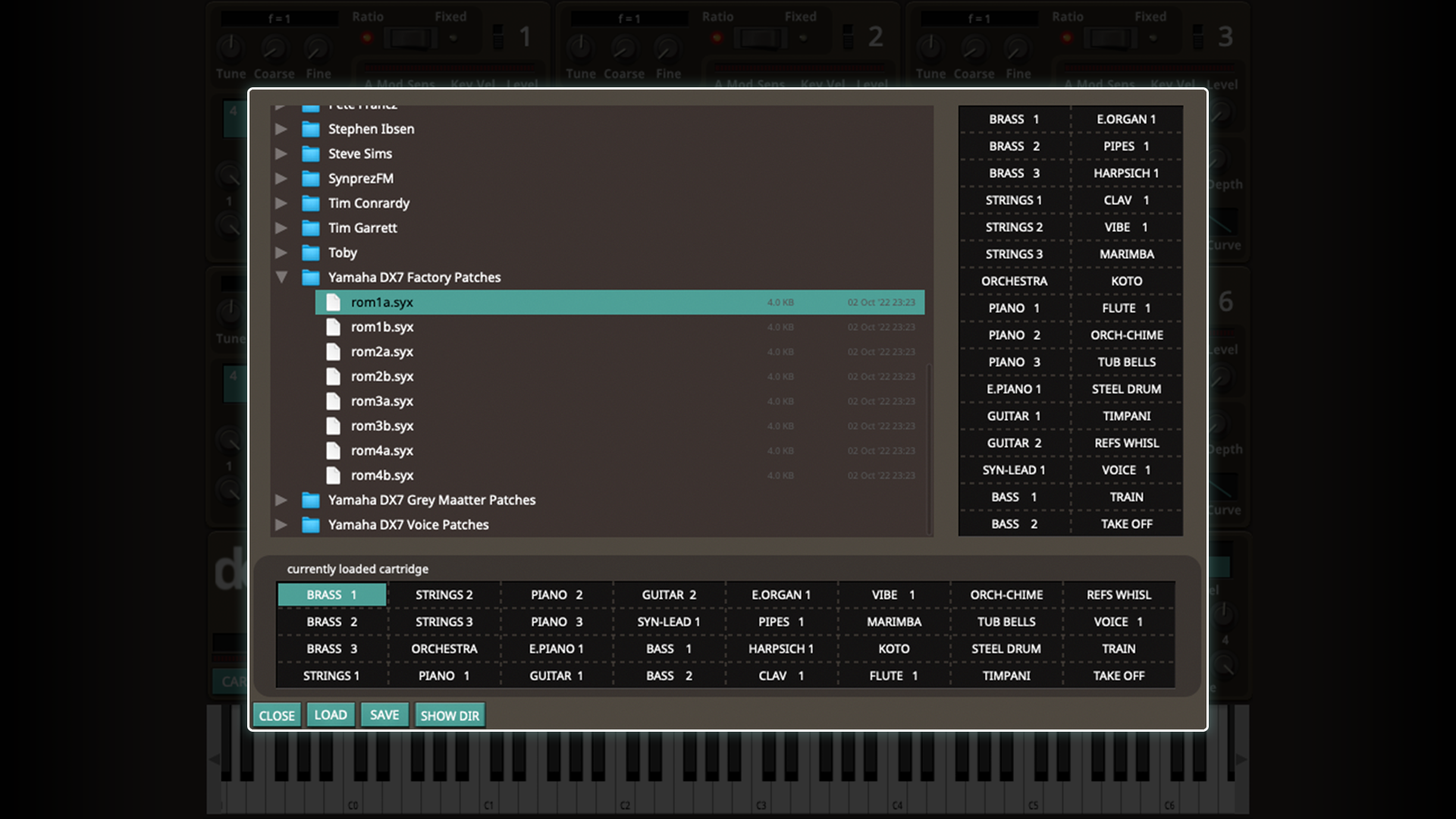
Designing your own sounds
When it comes to designing your own patches on Dexed (and/or the DX7), the devil is in the detail, and I could probably write a small novel’s worth of instructions, suggestions, ideas, possibilities, etc. However, in order to keep this article concise, let’s look at a few simple steps which I recommend taking when designing your own FM tones.
- 1. Select INIT to reset all operators to default parameters (Operators 2 through 6 have their Level turned all the way down on INIT, and so do not influence tone, which is what we want at this stage)
- 2. Select Algorithm 3 (as this has two linear stacks of three operators - this will make sense later)
- 3. Turn up the level of Operator 2 and observe how this changes the tone
- 4. Begin making small tuning adjustments to Operator 2 and observe how the tone changes
- 5. Once you’ve shaped the tone to your liking, adjust the envelope of Operator 2 and observe how the tone evolves
Many years ago, when I first learned to program DX synthesisers, I found that the above process gave me some understanding of how Modulator tuning influenced tone. However, working with only two operators will still feel rather crude, so let’s keep going.
- 6. Once you’re satisfied with the tone from two operators, raise the Level of Operator 3
- 7. Make small adjustments to the tuning and observe the impact this has on the tone
- 8. Make adjustments as desired to the Envelope Generator of Operator 3
Note that in this instance, one parameter change on Operator 2 will induce a degree of timbral change in the output sound, whereas the same amount of parameter change on Operator 3 will induce a much greater degree of timbral change in the output sound.
This is because Operator 3 alters the modulation of Operator 2, which in turn, is modulating Operator 1. There’s a complicated square-root mathematical formula behind this, but think of it as a timbral-modulation-butterfly-effect; the further away a Modulator is from the Carrier in the signal chain, the greater its influence on tone.

Now we’re playing with three operators, things begin to get more tonally complex. For the sake of the exercise, turn off Operators 1, 2 and 3 (there should now be no sound), and repeat the above process with Operators 4, 5 and 6 (in place of Operators 1, 2 and 3 respectively). Raise levels and adjust tuning to taste. Note that on this algorithm (Algorithm 3), Operator 6 has a feedback loop, so be sure to also experiment with the Feedback dial to hear the impact that has on tone.
- 9. Design a very different tone (to what you previously made with Operator 1, 2 and 3)
- 10. With your new tone created, turn Operators 1, 2 and 3 back on again
- 11. Adjust the output levels of Operators 1 and 4 to establish a pleasing tonal blend
- 12. Bask in the epicness of your 6-Operator FM tone creation!

Chances are, the first few times you design an FM tone, it will sound a bit crude, a bit gnarly and not as musical or lush as many of the factory presets, but don’t let that put you off. Programming FM synthesis requires practice as they’re very detailed and specific pieces of equipment, with a great deal of variables and nuance.
Consider that if you’re reading this, you’re probably a musician, which means you’ve probably poured hours into learning an instrument and/or a DAW. Your early musical creations were probably very rough, but after a while, things began to get a lot better. Programming FM synthesis is a similar process.
It requires practice and experience, in order to develop the necessary intuition and feeling for what works and what doesn’t. Be patient! Don’t be afraid to just practice and experiment programming FM synthesis without pressuring yourself to produce good results. You’ll soon get the hang of it and start using custom patches in your music-making.
Iconic patches
Let’s take a look at a few of the DX7’s best known factory preset patches that you can instantly recall and use in Dexed.
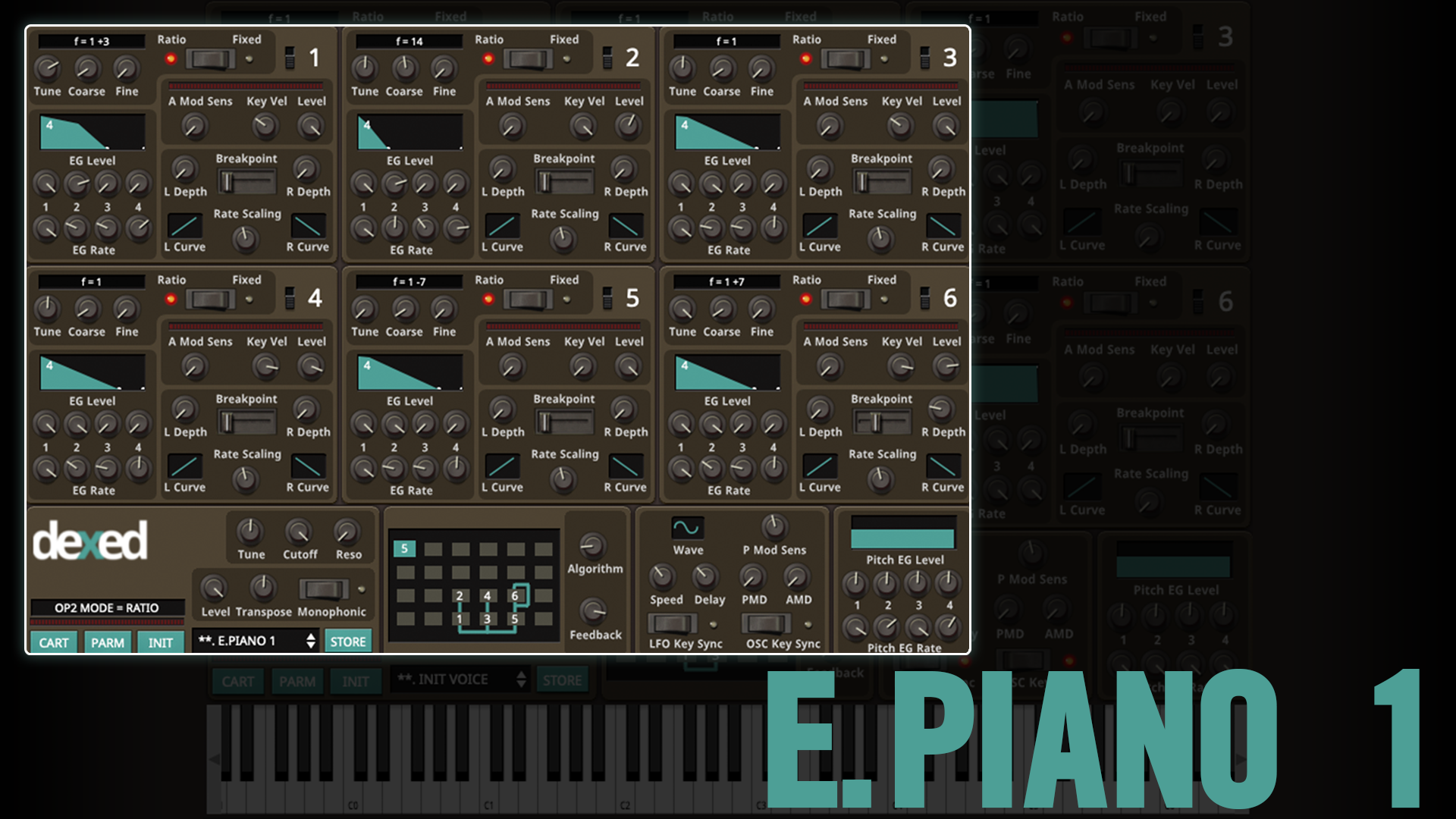
E.Piano 1 - You’ll know this patch when you hear it! You’ll find it in countless pop songs from the 80s and early 90s (especially if you’re a Whitney Houston fan!). You may also recognise this patch from TV shows such as Twin Peaks, or perhaps even the iconic Dire Dire Docks theme from Mario 64!
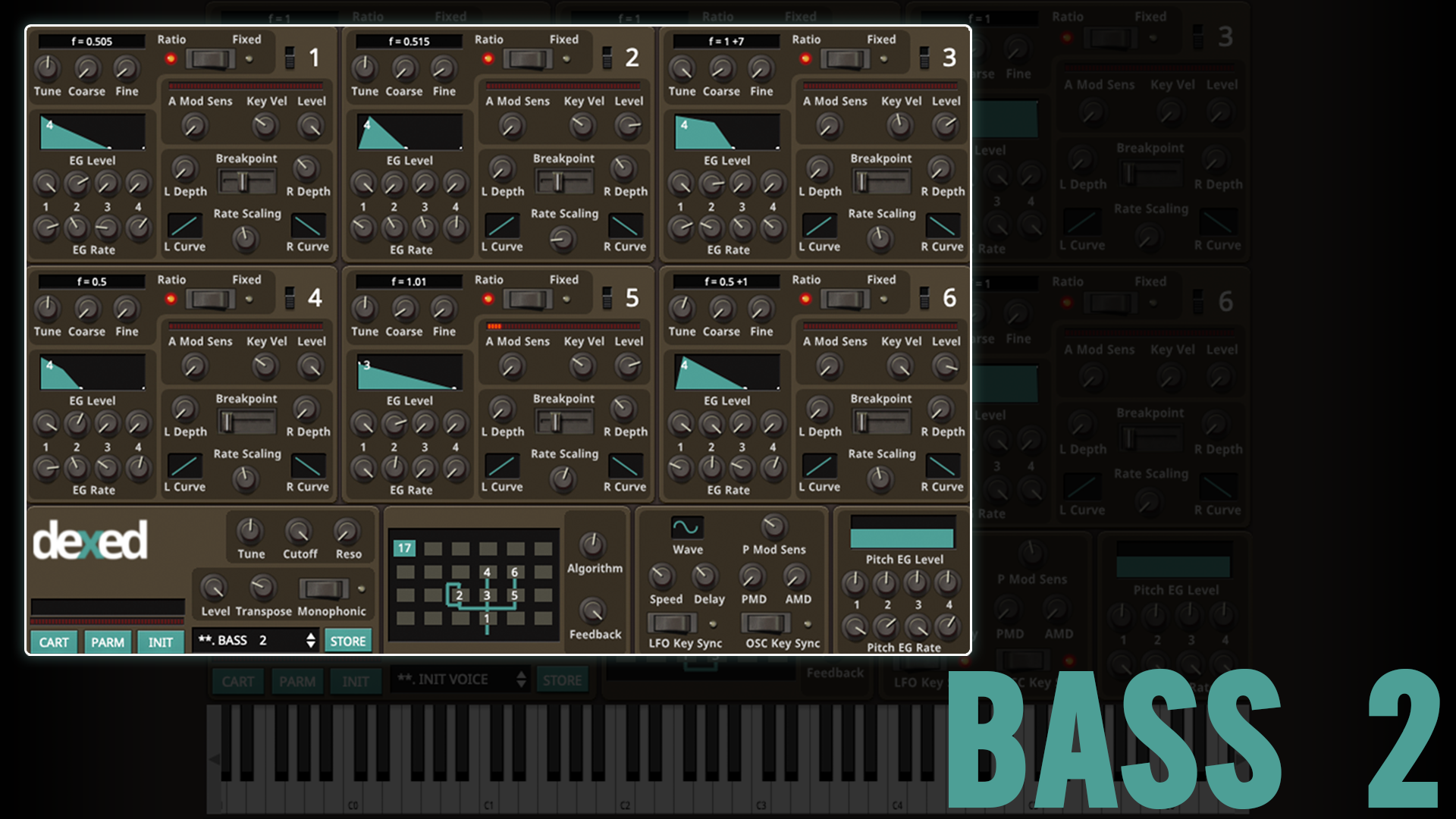
Bass 2 - Take My Breath Away - this iconic bass patch was used for the main riff of the smash-hit single from Top Gun.

Caliope - What’s Love Got to Do With It - Tina Turner’s smash-hit of from 1984 used this patch for the intro hook.
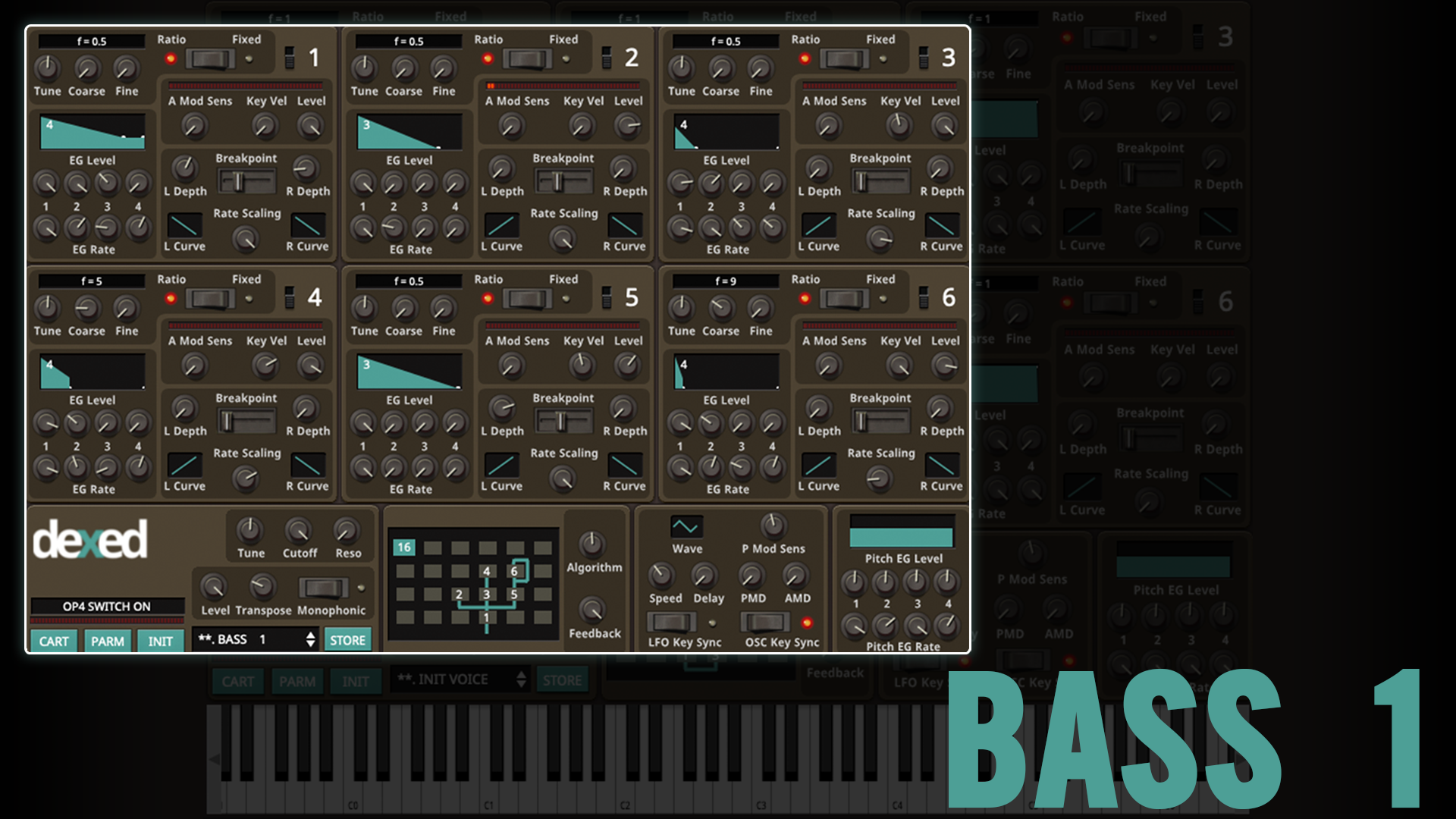
Bass 1 - Take On Me... need I say any more?
This only scratches the surface in terms of iconic patches, and if you click through the factory presets you’ll find yourself regularly thinking “I know that sound…!”, such was the prolific use of this synthesiser throughout the 1980s and beyond.

Conclusion
Sometimes it’s easy to overlook free software synthesisers such as Dexed, and one could be forgiven for assuming that a freebie is likely just a second-rate product versus a priced alternative.

The best free VST synth plugins 2022: wavetable, FM, virtual analogue and more
However, as mentioned above, unlike digital versions of analogue synths (which strive to capture the character and imperfections of analogue circuitry in a digital realm), the DX7 was digital to begin with, so there’s no analogue modelling to worry about whilst in the pursuit of authenticity. The DX7 by its very nature lays out a digital roadmap that the brilliant people at Digital Suburban have vehemently followed, delivering something that’s as close to the original DX7 as one could hope to get.
Install Dexed and you will have added a true icon of synthesis to your production arsenal. The DX7 left a sizeable imprint on the musical culture of the 20th Century and arguably shaped the sound of a decade’s worth of pop music, radio jingles, TV themes, and even video-games (as many arcade machines and consoles of the era used a simplified, 4-operator version of the DX7’s chip-set as their sound generators).
This depth of cultural saturation could never have been foreseen by Yamaha when they first partnered with John Chowning to develop this instrument. Regardless, their work was nothing short of masterful, as the principles of linear FM synthesis share a lot of common ground with the science that underpins technologies such as analogue modelling, pitch correction, time-stretching and more.
It’s not hyperbole to say that the DX7 was a defining moment in the evolution of music-technology and way ahead of its time. Furthermore, we’re incredibly privileged to have such a faithful (free!) recreation of this icon, in the form of Dexed.
- If you enjoyed this free synth tutorial, check out the previous articles in this series...
- Fantastic (free) synths and how to use them: TAL-NoiseMaker
- Fantastic (free) synths and how to use them: DiscoDSP OB-Xd
- Fantastic (free) synths and how to use them: Magical 8bit


“OSC” Steve is a composer, producer and educator with a background in piano, synthesisers and sound-engineering. He is an established, independent artist in the Synthwave and Retrowave music scenes, and has composed for several independent video-games including Nintendo Switch™ titles.
